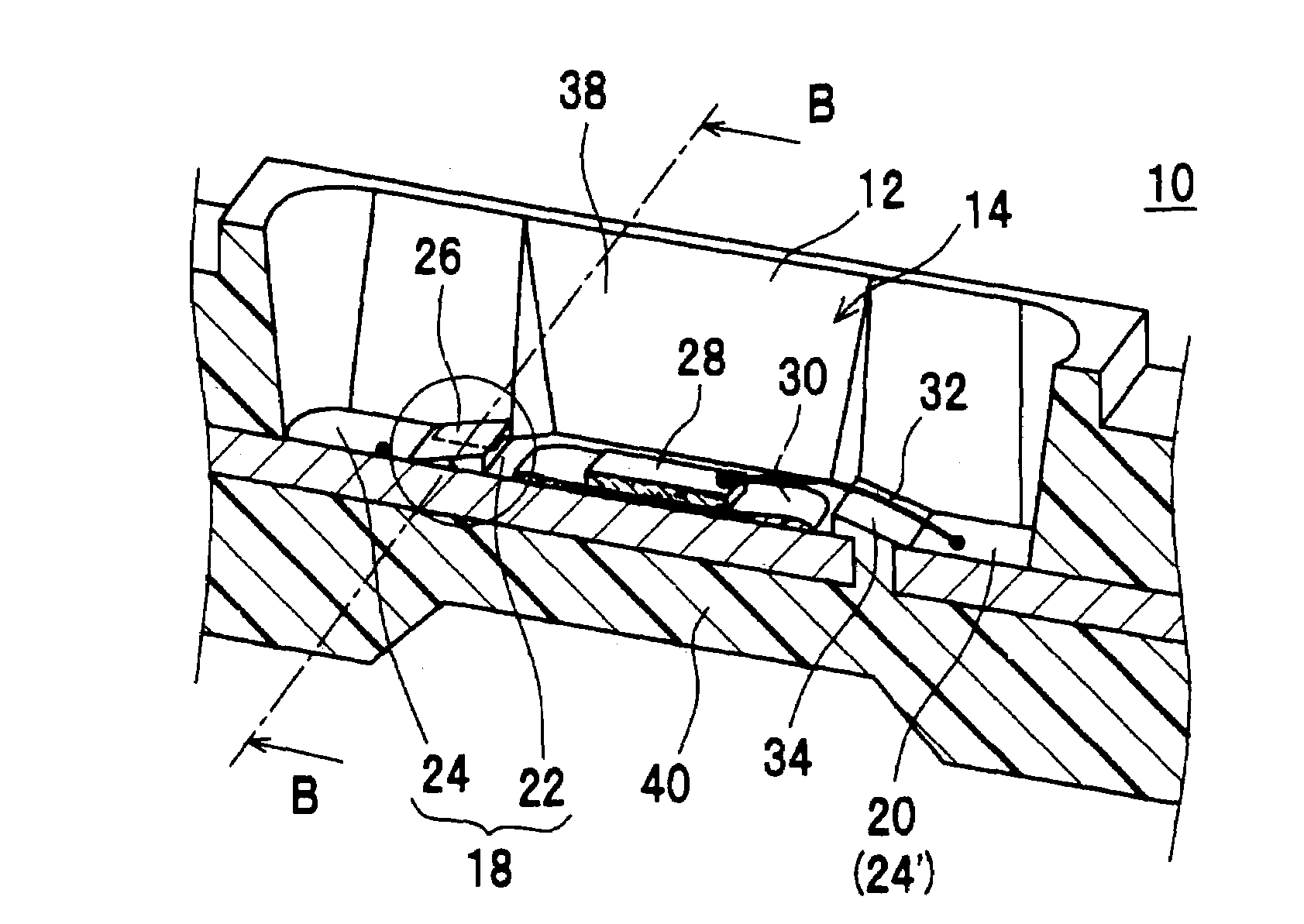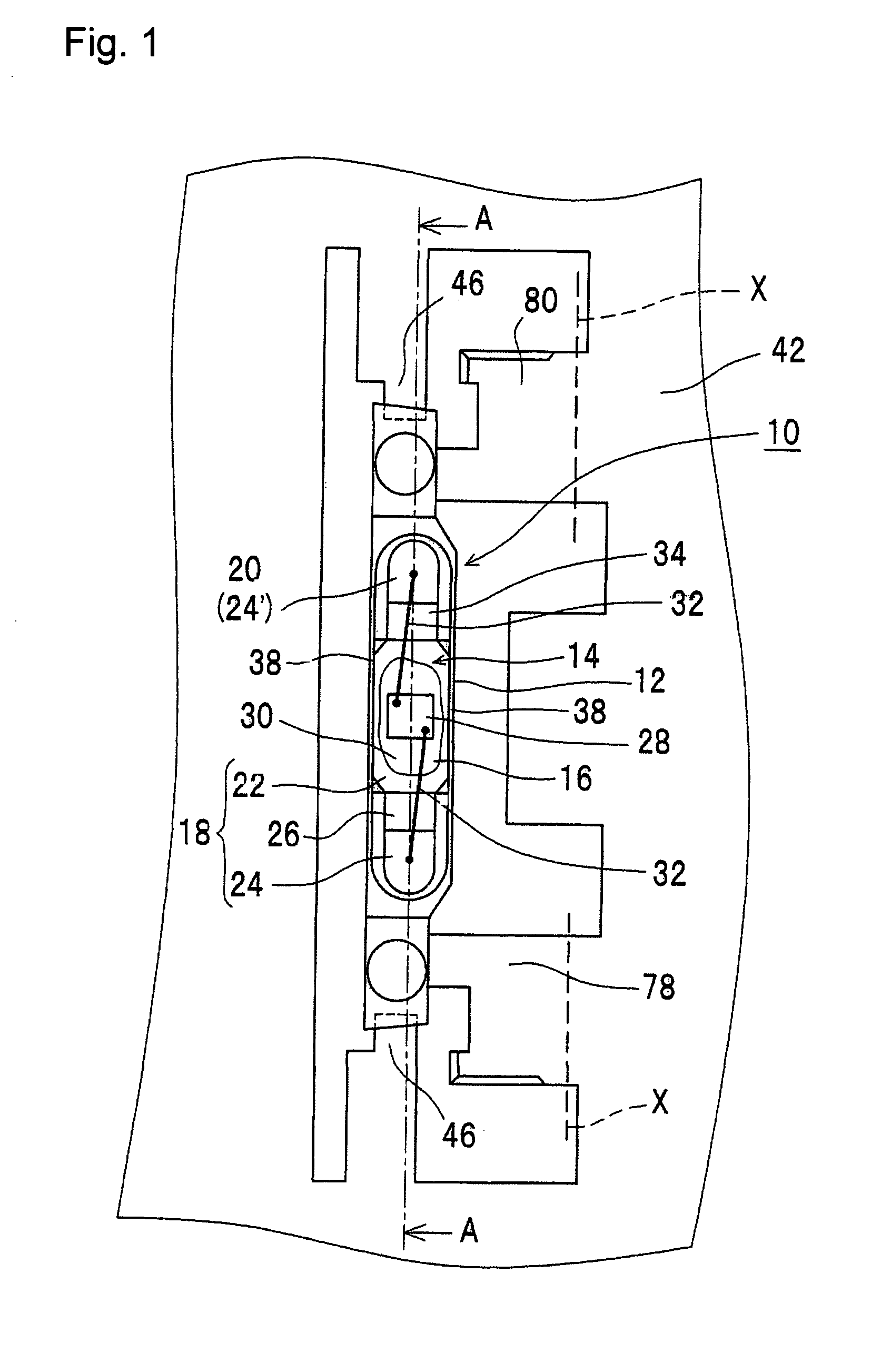Semiconductor device
a technology of semiconductor devices and side walls, applied in semiconductor devices, semiconductor/solid-state device details, coatings, etc., can solve problems such as local insufficient filling, and achieve the effects of increasing bonding strength, increasing cross section of first walls, and increasing bonding strength between the first wall and the side wall of the housing
- Summary
- Abstract
- Description
- Claims
- Application Information
AI Technical Summary
Benefits of technology
Problems solved by technology
Method used
Image
Examples
first embodiment
[0067]FIG. 1 and FIG. 2A show a mid stage of the process of manufacturing the semiconductor device according to the first embodiment, which becomes as shown in FIG. 6 in the final state. The semiconductor device 10 shown in FIG. 6 is extremely thin and is used as a thin light emitting device which uses a semiconductor light emitting element as the semiconductor element 28.
[0068]The semiconductor device 10 of the first embodiment comprises a housing 12 having a recess 14, a first lead electrode 18 and a second lead electrode 20 which are exposed on the bottom surface 16 of the recess 14. The first lead electrode 18 has a die bonding area 22 and a wire bonding area 24, while these areas are divided by a first wall 26 formed on the surface of the first lead electrode 18 so as to traverse the first lead electrode 18. The second lead electrode 20 is constituted from a wire bonding area 24′ only without die bonding area. A second wall 34 is formed to protrude between the first lead electr...
second embodiment
[0102]The semiconductor device of the second embodiment has a V groove 50 formed on the surface of the first lead electrode 18 as shown in FIG. 7A and FIG. 7B. The V groove 50 is located just below the first wall 26. The semiconductor device 10 of the second embodiment is similar to the first embodiment except for the first lead electrode 18 and the first wall 26.
[0103]As shown in FIG. 7A through FIG. 7C, the first wall 26 extends across the surface of the first lead electrode 18 and is bonded on both ends thereof with the side wall 38 of the housing 12. In the second embodiment, the V groove 50 is formed on the surface of the first lead electrode 18, and the first wall 26 is formed on the V groove 50. The V groove 50 is preferably formed along the first wall 26 that separates the die bonding area 22 and the wire bonding area 24. In this case, the V groove 50, together with the first wall 26, separates the surface of the first lead electrode 18 into the die bonding area 22 and the w...
third embodiment
[0108]The first embodiment employs the notch 36 and the second embodiment employs the V groove 50. The semiconductor device of the third embodiment has both the notch 36 and the V groove 50 formed in the first lead electrode 18 as shown in FIG. 8A and FIG. 8B. With other respects, the third embodiment is similar to the first and second embodiments. Details of the notch 36 and the V groove 50 are also similar to those of the first and second embodiments except for the points described below.
[0109]As shown in FIG. 8A through FIG. 8C, the first wall 26 extends across the surface of the first lead electrode 18 and is bonded with the side wall 38 of the housing 12 on both ends.
[0110]In the third embodiment, the rectangular notch 36 is formed in an edge 181 of the first lead electrode 18 at a position where the first wall 26 is to be formed. This constitution, similarly to the notch 36 of the first embodiment, achieves the effect of improving the bonding between the first wall 26 and the ...
PUM
 Login to View More
Login to View More Abstract
Description
Claims
Application Information
 Login to View More
Login to View More - R&D
- Intellectual Property
- Life Sciences
- Materials
- Tech Scout
- Unparalleled Data Quality
- Higher Quality Content
- 60% Fewer Hallucinations
Browse by: Latest US Patents, China's latest patents, Technical Efficacy Thesaurus, Application Domain, Technology Topic, Popular Technical Reports.
© 2025 PatSnap. All rights reserved.Legal|Privacy policy|Modern Slavery Act Transparency Statement|Sitemap|About US| Contact US: help@patsnap.com



